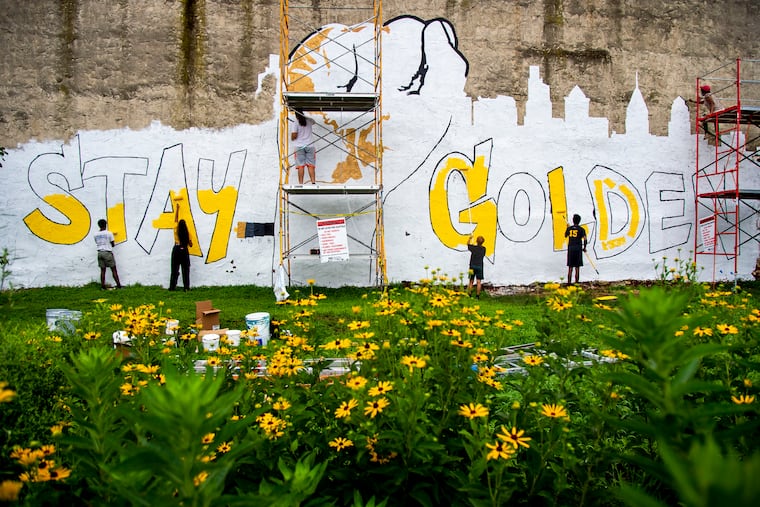The color gold and the powerful spirit of Black and brown people in a mural
The "Stay Golden" mural commemorates the powerful spirit of Black and brown people.

A mural painting is underway in Strawberry Mansion with a mission — a hope, the artists say, of “activating the community, reflect on the radical energy in the city and around the country, and commemorate the powerful spirit” of Black and brown people.
Stay Golden, as the piece is called, was organized and designed by Philadelphia artists Gerald Brown, Roberto Lugo, and Isaac Scott, and is going up at 33rd and Diamond Streets with help from Mural Arts Philadelphia.
» READ MORE: The threat to a John Coltrane mural shows how development can erase Black history in Philly
The three artists are not traditional muralists, having backgrounds in other media. Brown is a Chicago native who received a bachelor of fine arts degree from Syracuse University, with a double emphasis in sculpture and ceramics. Scott, a ceramic artist from Madison, Wis., is working on his master of fine arts degree at Temple University’s Tyler School of Art and Architecture. Lugo, an assistant professor at Tyler, uses porcelain as his medium of choice. His work is in major museums around the world.
Long involved in social causes through their art, the three participated in the Fishtown “End Racism Now” street painting and afterward wanted to keep the spirit generated by that project going. Brown liked that so many people came out and “were able to artistically contribute to the messaging.”
They approached Mural Arts about doing a street painting, but what they were offered was support in the creation of a mural.
The title, the artists said, is “reflective of a common usage of the color gold in African Diasporic communities. It is a unifying color among Black and brown people and speaks to the resilience of our people through adversity.”
The artists wanted the work to be done quickly, Scott said, “while in the moment with all the protesting that’s going on in the city and around the country.”
Scott started taking pictures when the coronavirus pandemic shut down his classes at Tyler. He created an Instagram account just for his photography and began posting color shots of flowers, power lines, murals and graffiti. Then the George Floyd protests began, and his posts were in black and white, starting with an image of a fist in the air he made at the Philadelphia Museum of Art during the first protest, on May 30. He marched with protesters, photographing everything, and two days later was among those teargassed on I-676.
That fist shows up in their mural.
Brown wanted it to reflect “the urgency and immediacy” of what people were saying, and went door-to-door in the neighborhood and got residents to sign on to the project. Her aim was “to make sure the mural itself existed for the people.”
While it is not a Mural Arts project, the agency provided paint, supplies, scaffolding, and technical support.
Longtime artist David McShane assisted throughout, including with the projection transfer of the artists’ sketch to the wall.
Jane Golden, Mural Arts executive director, said, “We love that they are taking a moment in time and making it into a permanent mural with a powerful message.”